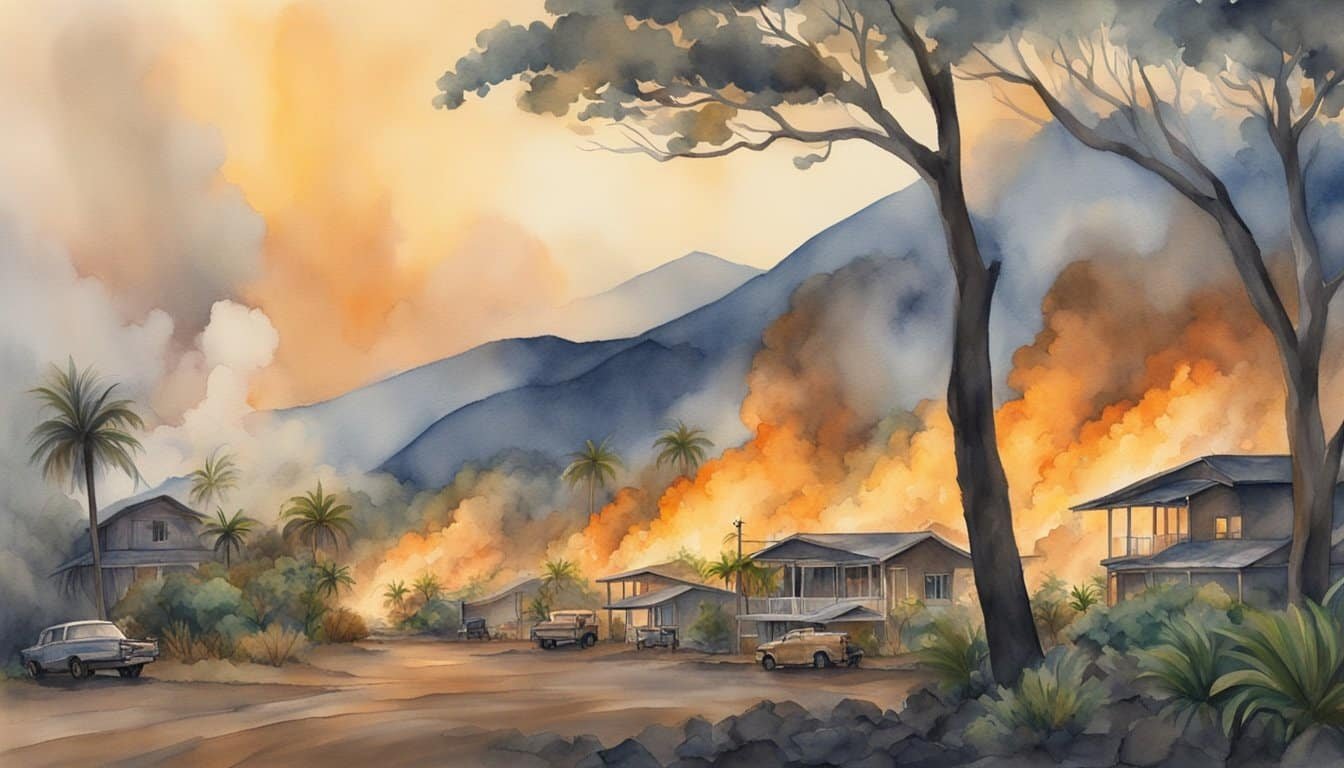Root Causes of Hawaii Fires
Hawaii’s mesmerizing landscapes are not immune to the destructive power of fires. From climate change factors to human negligence, and natural weather influences, various elements play crucial roles in the ignition and spread of fires across the Hawaiian Islands.
Impact of Climate Change
Climate change is playing a significant role in increasing the frequency and intensity of fires in Hawaii. The global warming phenomenon contributes to prolonged drought conditions and dry weather patterns, as chronicled by the US Drought Monitor. Such conditions desiccate vegetation, making it more susceptible to burning. For instance, areas like Maui have seen a shift towards abnormally dry spells, laying the groundwork for potential wildfires.
Human Activities and Negligence
Fires in Hawaii are often triggered by direct or indirect human activity. Discarded trash, unattended campfires, or malfunctioning power lines can rapidly ignite a blaze, especially in regions with dense dry brush, such as near Lahaina or various parks across the islands. Human actions can unintendedly lead to widespread damage; hence, awareness and caution are critical to preventing such disasters.
Natural Factors and Weather Influence
Natural weather phenomena also contribute to the onset and propagation of fires. Hurricane Dora, for instance, brought strong hurricane winds that can spread flames rapidly. The National Weather Service often warns of these conditions, with high temperatures, lightning from occasional storms, and increased atmospheric pressure patterns that align to create prime conditions for fires to spread. Wind, without a doubt, is the most significant atmospheric player in this scenario, with gusts in Hawaii capable of turning a small flame into a rampaging wildfire in mere moments.
Emergency Response and Recovery Efforts

The efforts to manage and recover from Hawaii’s wildfires such as the Lahaina fire are multifaceted, involving evacuation procedures, innovative firefighting strategies, and comprehensive aid and reconstruction initiatives.
Evacuation and Shelter
When wildfires threaten Hawaiian towns like Lahaina, urgent evacuation orders are put into place to protect residents. Maui County coordinates closely with local emergency services to establish safe routes and efficient transportation for those in need. Evacuees often find solace in emergency shelters, which are promptly set up in safer areas, providing basic necessities and support during the displacement.
- Established shelters: Maui High School, Lahaina Civic Center
- Emergency services involved: Maui Police Department, Coast Guard
- Number of residents evacuated: Approx. 1,000 (Lahaina fire)
Firefighting and Containment Strategies
Firefighters and crews from various agencies, including the National Guard, cast themselves into the fray to combat the flames. They employ an array of tools and tactics, from traditional ground efforts to advanced technologies like thermal imaging to detect hotspots.
- Agencies involved: Maui Fire Department, National Guard
- Containment tools: Helicopters with water buckets, Fire retardants, Bulldozers to create firebreaks
- Recent success: 80% containment of the Maui wildfires within 72 hours.
Aid and Reconstruction
After the immediate fire threat subsides, the focus shifts to recovery and aid. Organizations like FEMA, alongside Governor Josh Green’s office, play pivotal roles in coordinating federal and state aid packages. These funds are paramount in rebuilding infrastructures and providing financial support to those who have suffered losses.
- Rebuilding efforts: Infrastructure repair, Home reconstruction
- Aid organizations: FEMA, Hawaiian Red Cross
- Aid received: Over $5 million approved for Maui County recovery efforts
Planned recovery strategies enact measures to mitigate future incidents, aiming to prevent comparable levels of damage and devastation associated with natural disasters like the Hawaii wildfires.
Impact on Communities and Environment

Wildfires in Hawaii, particularly on the Hawaiian Island of Maui, have serious consequences for both the communities living there and the surrounding environment. The picturesque town of Lahaina, for instance, has witnessed the destructive power of blazes, which not only threaten homes and iconic landmarks like the Banyan tree on Front Street but also pose severe risks to residents, tourists, and local shops.
Social and Economic Repercussions
In Maui County and across the United States, wildfires such as those in Lahaina lead to drastic social and economic impacts. The community faces significant challenges, including displacement of residents, loss of property, and a profound sense of uncertainty. The economic fallout is equally stark, with damage to businesses and tourism—a crucial income source for the community. For instance, when smoke blankets the area, it not only poses health risks but also deters the lifeblood of the economy: the tourists. The cost of these wildfires extends well into the realm of emergency services, post-disaster cleanup, and rebuilding efforts, not to mention the potential increase in insurance premiums for homeowners.
- Displacement of residents and tourists
- Loss of homes and buildings
- Damage to local shops and tourist attractions
- Health risks from smoke exposure
- Economic strain on emergency and rebuilding services
Environmental and Ecological Damage
The wildfires’ environmental impact is also considerable, with vast stretches of lush Hawaiian flora and fauna subjected to destruction. Wildfires disrupt the delicate ecological balance, destroying native vegetation and threatening local wildlife. In some instances, fires can lead to long-term degradation of soil quality and an increased risk of erosion, particularly given the Hawaiian Islands’ proximity to the Pacific Ocean. Satellite images of wildfires globally have made it clear that the effects are not localized but can influence climate patterns outside the immediate area. Moreover, the recurrence of such blazes amid the climate crisis indicates a pressing need for sustainable environmental management.
- Destruction of native trees and vegetation
- Threat to local fauna
- Soil degradation and increased erosion
- Influences on climate beyond the immediate area
For a deeper understanding of the fire effects in Hawaii’s coastal lowlands, a study provides insights into the short-term impact on plant communities. Another research article discusses the interaction between wildfires and nonnative species across different Hawaiian landscapes, stressing the complex relationship between fire, vegetation, and community dynamics. To grasp the broader implications, including fire impacts on native plant compositions along Hawaii’s elevation gradients, one may refer to related findings.

